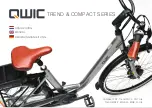
24
XIII. Electric system
XIII-1. E-bike fundamental legal principles
The fundamental idea behind the E-bike is not only to be able to cover greater distances more
quickly, but also do this comfortably. You can choose to relax and let the bike do the work, exert
yourself more physically, or simply to get from A to Bas fast as possible. You can decide this
yourself by choosing an appropriate assist level .This gives you more confidence on the road,
as the powerful acceleration gives you more control and a greater degree of security. Your E-bike
assists you with up to 500W watts of power which takes you up to the speed of 32(km / h).
XIII-2. These statutory requirements apply for a E-bike
•
The motor is designed only to provide edaling assistance, i.e. it can only "assist" the rider
when he/she turns the pedals.
•
The average motor output must not exceed 500 W.
•
As the speed increases, the rate at which the motor output reduces must also increase more
intensely.
•
The motor must switch off once the bike reaches a speed of 32(km / h).
•
The motor must switch off once the brake work
XIII-2.1: Meaning for the rider
Check your local state or provincial bylaws in accordance to rules and regulations regarding
where you can ride your e-bike and helmet requirements.
XIII-2.2: Pushing assistance (If the E-BIKE is equipped with it)
You can have your specialist cycle shop fit what is known as "pushing assistance" to your bike.
The pushing assistance moves the E-bike slowly at a maximum speed of 6km / h without you
having to turn the pedals, e. g. if you are maneuvering in a tight space or are pushing your E-bike
out of a basement garage.
The pushing assistance is not suitable for use as starting assistance.
















































